Design and Verification of Assessment Tool of Shortwave Communication Interference Impact Area
Abstract
:1. Introduction
2. Design and Method
- (1)
- Base layer
- (2)
- Data layer
- (3)
- Model layer
- (4)
- Service layer
- (5)
- Application layer
2.1. Equipment Parament
2.2. Ionospheric Environmental Database
2.3. Shortwave Communication Interference Zone Assessment Method
2.3.1. Shortwave Interference Zone Field Strength Assessment
2.3.2. Interference Zone Grid Matrix
3. Simulation and Results
- (1)
- Equipment Modeling: Shortwave interference equipment parameters, such as antenna dimensions, maximum gain, and standing wave ratio, are inputted through a user-friendly visual interface. The antenna patterns at various frequencies were then established based on the specified parameters.
- (2)
- Determining Transmission and Reception Positions: The equipment’s deployment position serves as the emission point for the interference signal, while the calculation of the received field strength at the interference footprint is designated as the receiving point.
- (3)
- Calculating the Grid Matrix: A grid link was established to facilitate precise calculations using the interference impact area grid matrix method.
- (4)
- Analyzing Ionospheric Parameters: Simulating the state of the ionosphere in the assessment area involves employing an ionospheric parameter model. This model considers factors such as the ionospheric height, density distribution, and electron density to determine the ionospheric state based on temporal and spatial variations.
- (5)
- Matching Antenna Pattern: Selecting the emission frequency of the device prompts an automatic match with the corresponding antenna pattern or the closest antenna pattern within the established set.
- (6)
- Propagation Prediction: Employing the ITU-R P.533-14 wave propagation model, the simulation of shortwave signal propagation in the ionosphere incorporates reflection, refraction, and scattering characteristics across different frequency bands. The model calculates the signal’s propagation path in the ionosphere based on ionospheric parameters and emission signal frequency, determining interference strength at each grid link’s fall point.
- (7)
- Visualization: Setting an interference strength threshold enables the visualization of the interference footprint based on the grid interference strength. Grid points below the threshold were not excluded from the visualization process.
4. Experiment and Verification
4.1. Experimental Receiving Equipment
4.2. Experimental Receiving System Connection
4.3. Experimental Process
4.4. Comparison of Experimental Results
5. Conclusions
Author Contributions
Funding
Institutional Review Board Statement
Informed Consent Statement
Data Availability Statement
Conflicts of Interest
References
- Wang, J.; Shi, Y.; Yang, C.; Zhang, Z.; Zhao, L. A Short-Term Forecast Method of Maximum Usable Frequency for HF Communication. IEEE Trans. Antennas Propag. 2023, 71, 5189–5198. [Google Scholar] [CrossRef]
- Wang, J.; Shi, Y.; Yang, C. An Overview and Prospects of Operational Frequency Selecting Techniques for HF Radio Communication. Adv. Space Res. 2022, 69, 2989–2999. [Google Scholar] [CrossRef]
- Wang, J.; Yang, C.; An, W. Regional Refined Long-term Predictions Method of Usable Frequency for HF Communication Based on Machine Learning over Asia. IEEE Trans. Antennas Propag. 2022, 70, 4040–4055. [Google Scholar] [CrossRef]
- Lin, J.; Wang, D.; Yan, C. Research on integrated interference evaluation against HF communication channel. IEEE Access 2018, 6, 61575–61584. [Google Scholar]
- Wu, L.; Shang, H.; Lü, S. An interference estimation method for shortwave communication system based on wavelet packet transform and support vector regression. J. Appl. Remote Sens. 2017, 11, 035013. [Google Scholar]
- Kumar, A.; Singh, S.P.; Garg, P.K. HF radio wave propagation analysis in the presence of interference using generalized regression neural network. J. Atmos. Sol. Terr. Phys. 2018, 177, 137–147. [Google Scholar]
- Kaushik, H.S.; Bhattacharya, B.K.; Balakrishnan, R. Simplified models for ionospheric scintillation effects on HF radio communication in the equatorial ionosphere. J. Atmos. Sol. Terr. Phys. 2019, 193, 105058. [Google Scholar]
- Lee, H.Y.; Uhm, M.S.; Lee, G.S. Interference mitigation techniques for shortwave radios. J. Commun. Netw. 2018, 20, 609–625. [Google Scholar]
- Kim, D.; Lee, C.; Kim, J. Analysis of interference on high frequency communication systems using HF diplex filters. J. Electrostat. 2017, 88, 104–110. [Google Scholar]
- Liu, L.; Liu, Y.; Sun, J. A method for the suppression of interference in shortwave communication systems based on the grey wolf optimization algorithm. Measurement 2017, 98, 115–124. [Google Scholar]
- Dorji, U.; Kim, G.H.; Kim, J.H.; Bak, K.H. Development of a compact HF channel sounder for shortwave radio communications in low-latitude regions. Meas. Sci. Technol. 2020, 31, 064003. [Google Scholar]
- Ahmed, S.M.; Nasr, M.S.; El Sayed, M.A. Radio communication interference in tropical regions: Model development and analysis. J. Atmos. Sol. Terr. Phys. 2017, 163, 118–129. [Google Scholar]
- Mestan, M.; Ertugrul, N. Interference analysis of a shortwave communication system by using a psychoacoustic-based speech quality measure. Int. J. Electr. Eng. 2016, 16, 35–41. [Google Scholar]
- Kaneko, Y.; Ogawa, T.; Ikeda, K. HF interference effects on IQ data of software-defined radios. Radio Sci. 2016, 51, 2198–2208. [Google Scholar]
- Pan, X.; Wei, G.; Wan, H.; Lu, X.; Li, W.; Wang, Y. Prediction model of blocking interference effects for electronic equipment under the condition of the dual-frequency narrow spectrum in-band electromagnetic radiation. Chin. J. Radio Sci. 2020, 35, 377–385. [Google Scholar] [CrossRef]
- Du, H.; Yu, Y.; Du, B. Evaluation method of complex electromagnetic environment adaptability for communication station. Chin. J. Radio Sci. 2018, 33, 619–623. [Google Scholar] [CrossRef]
- International Telecommunication Union (ITU). Recommendation P.1239-2: Characteristics of the Ionosphere-Propagation Data Required for the Design of HF Systems; International Telecommunication Union (ITU): Geneva, Switzerland, 2007. [Google Scholar]
- ITU-R. Method for the Prediction of the Performance of HF Circuits, ITU-R P.533-14; International Telecommunication Union: Geneva, Switzerland, 2017. [Google Scholar]
- Watt, A.; Watt, M. 3D Computer Graphics, 4th ed.; Pearson Education Limited: Beijing, China, 2017. [Google Scholar]

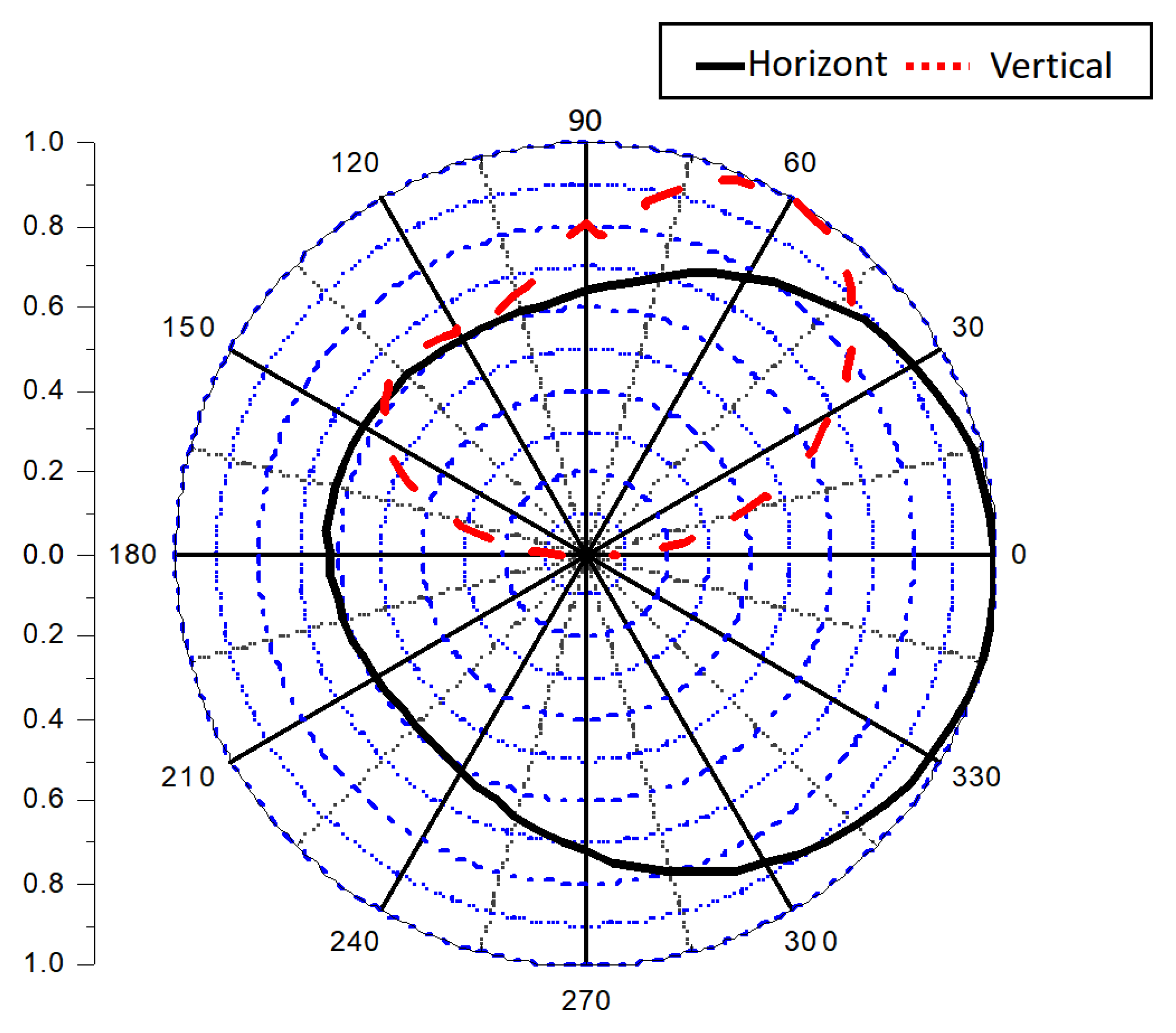
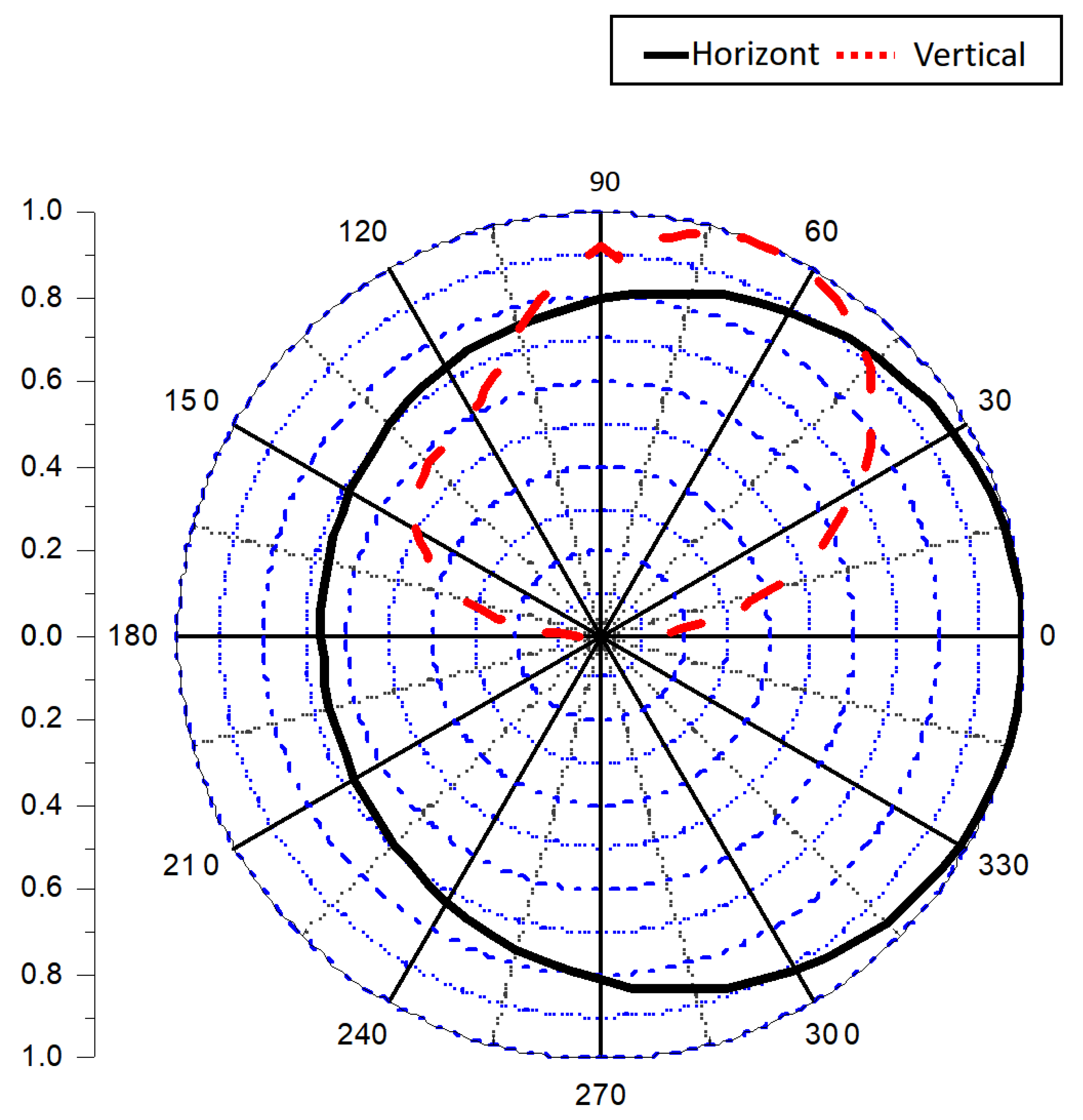
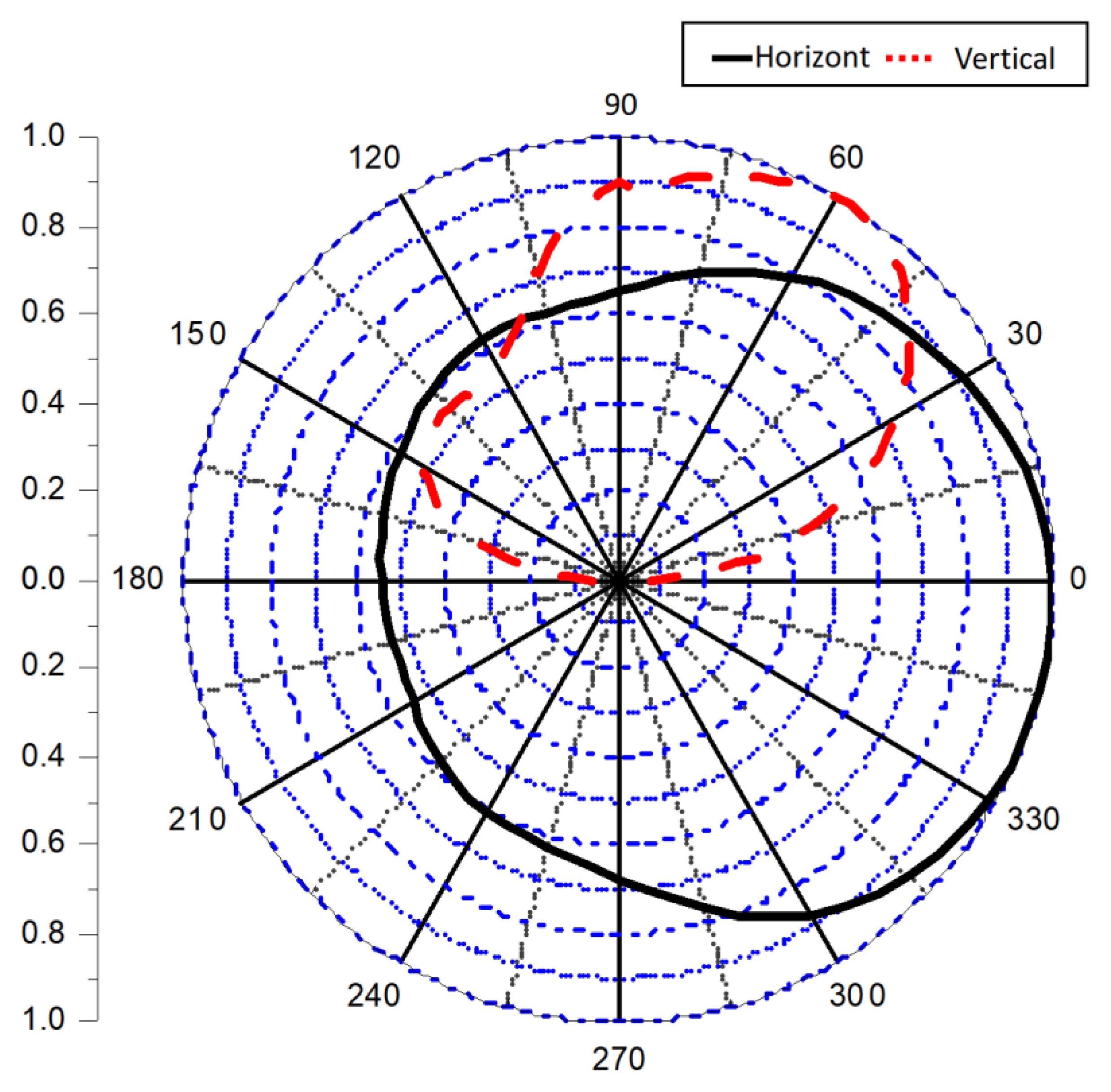
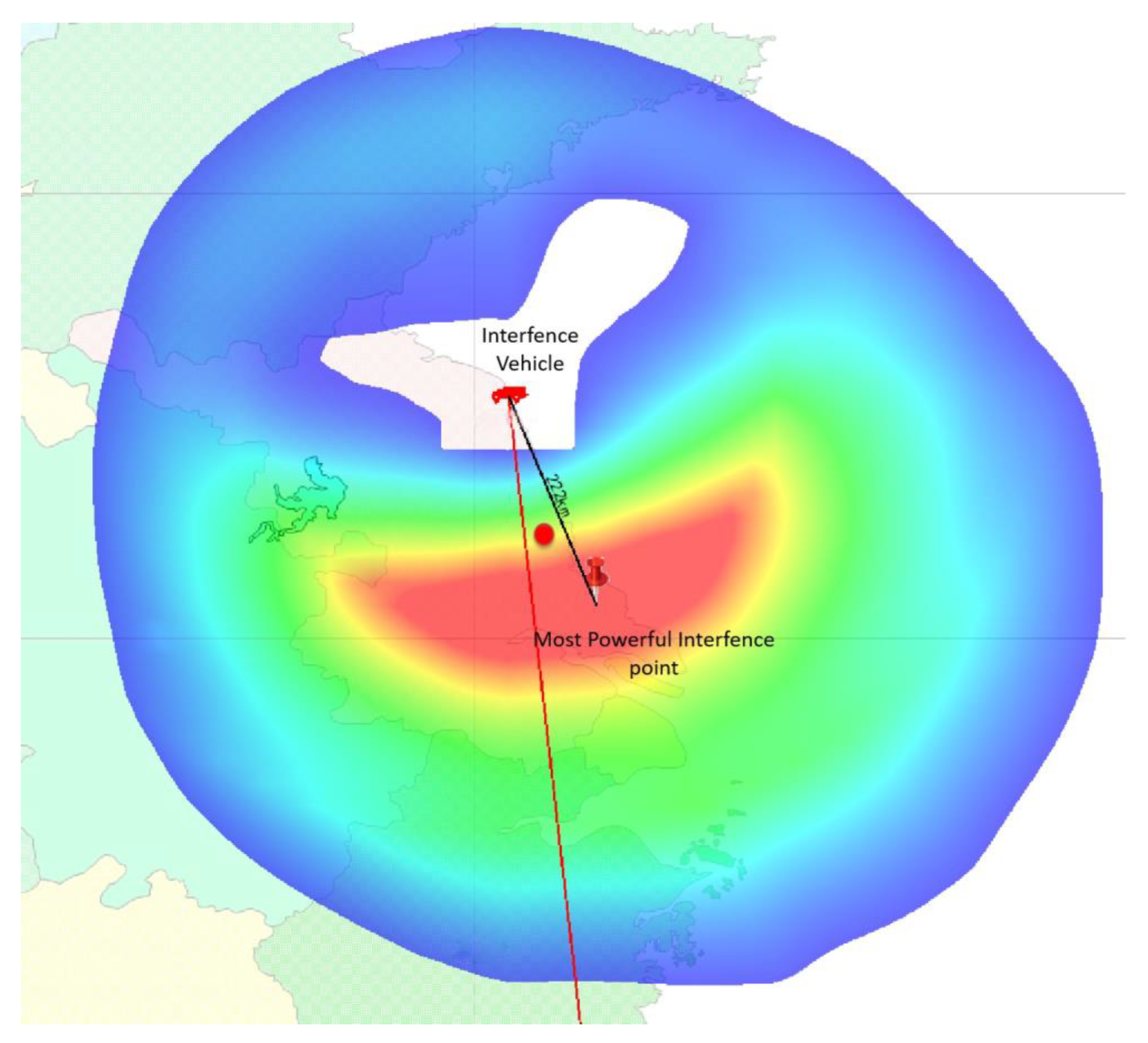
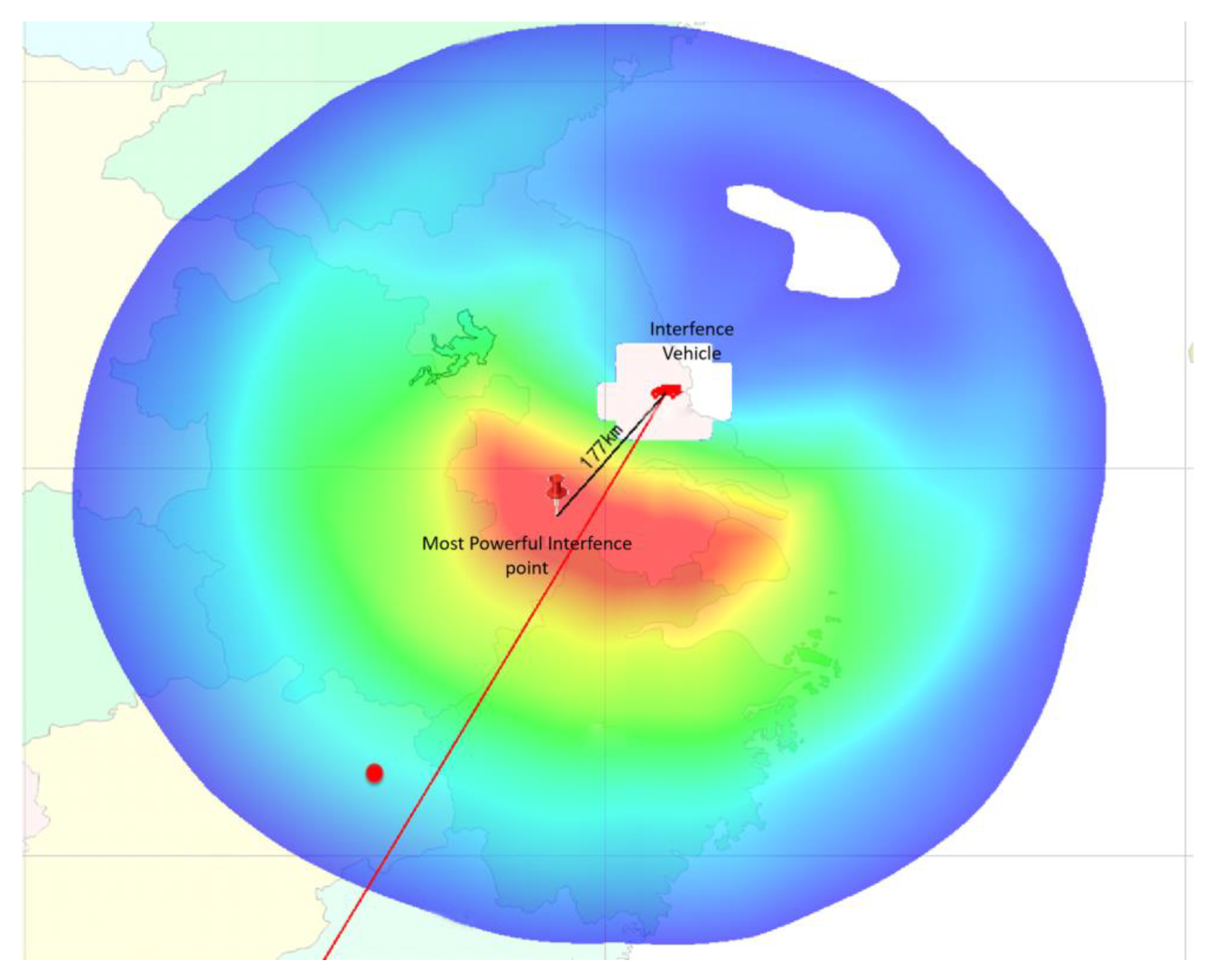
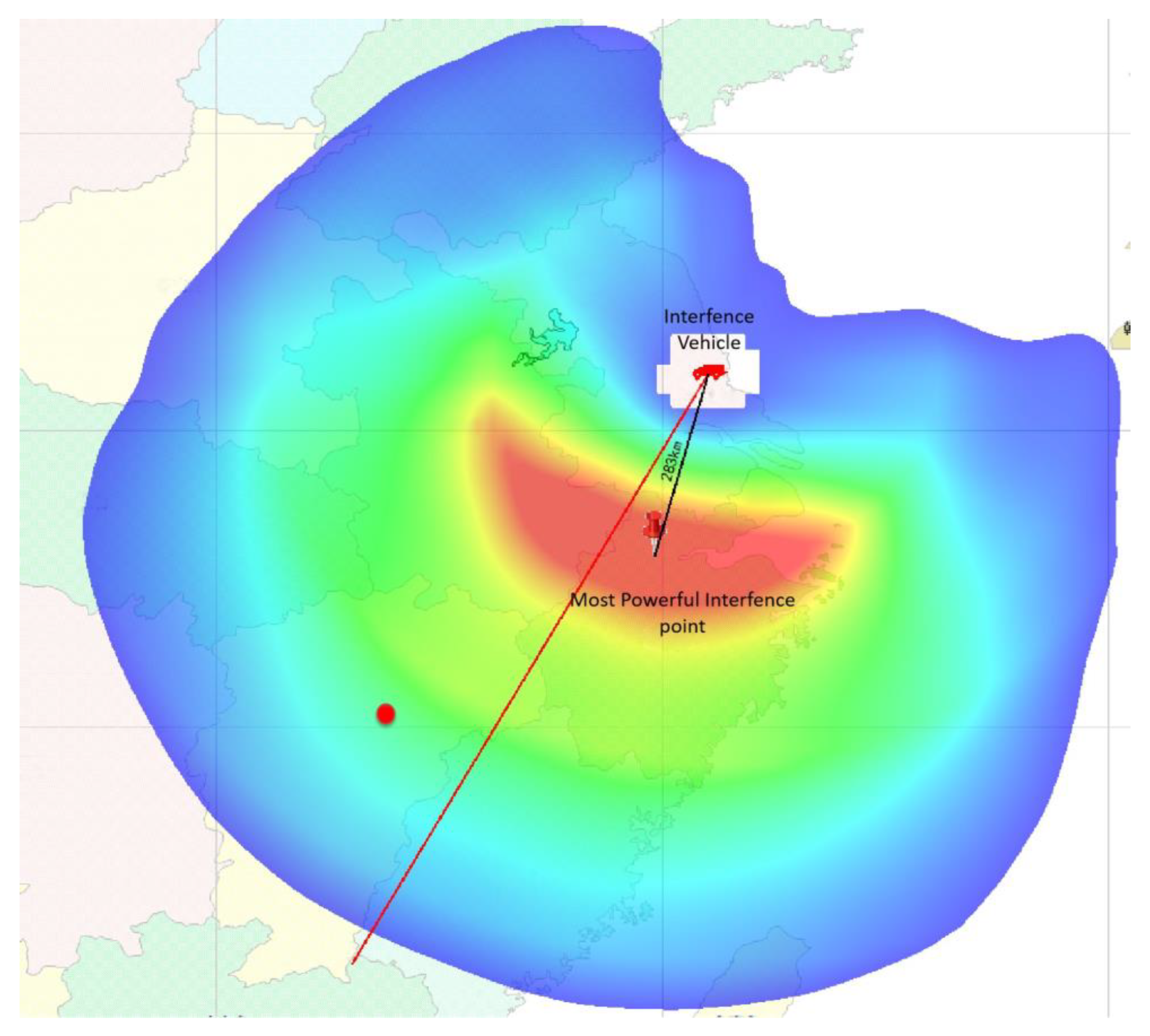

| Item | Parameter |
|---|---|
| Size | 22 antenna arrays, the longest array is 32.05 m, the shortest array is 1.76 m, and the erection area is 32 m × 57 m |
| Antenna type | Log-periodic antenna |
| Antenna gain | 6–8 dB |
| Impedance | 50 Ω |
| Power | 15 kW |
| VSWR | ≤2 |
| Main beam elevation angle | 40°–60° |
| Interference frequency step | 1 MHz |
| Parameter | Units | Description |
|---|---|---|
| foE | MHz | The critical frequency of the ionospheric E layer |
| foF2 | MHz | The critical frequency of the ionospheric F2 layer |
| M(3000)F2 | - | Propagation factor of 3000 km |
| Sunspot | - | Solar activity parameter |
| Ionospheric density | el/m3 | The electron density distribution in the ionosphere |
| Ionospheric height | m | The bottom or top altitude of the ionosphere |
| Ionospheric temperature | K | The temperature distribution of gases in the ionosphere |
| Electron density profiles | el/m3 | The variation of electron density with altitude in the ionosphere |
| Equipment Name | Manufacturer | Type | Function |
|---|---|---|---|
| EMI Receiver | R&S | ESCI | Capture and analyze EMI signals. |
| Standard Rod Antenna | R&S | HFH2-Z1 | Receive short-distance signal |
| Computer | Lenovo | ThinkPad T450 | Display monitoring data |
| GPIB card | Agilent | 82357A | Connecting receiver and computer for data transfer and control |
| Transmitting Position | Receiving Position | Distance | Azimuth | Date | Test Time | Transmitting Power |
|---|---|---|---|---|---|---|
| (120.32, 34.05) | (120.51, 32.42) | 155 km | 174° | 29 October 2020 | 16:45 | 10 kW |
| (120.59, 32.35) | (117.51, 28.48) | 525 km | 213° | 31 October 2020 | 08:53 | 10 kW |
| (120.59, 32.35) | (117.51, 28.48) | 525 km | 213° | 31 October 2020 | 10:45 | 10 kW |
| (120.59, 32.35) | (117.51, 28.48) | 525 km | 213° | 31 October 2020 | 15:06 | 10 kW |
| (120.59, 32.35) | (116.57, 27.41) | 675 km | 214° | 1 November 2020 | 10:36 | 10 kW |
| (120.59, 32.35) | (116.57, 27.41) | 675 km | 214° | 1 November 2020 | 17:39 | 10 kW |
| No. | Frequency (MHz) | Measured Position | Simulated Result (dBμV/m) | Measured Result (dBμV/m) | |
|---|---|---|---|---|---|
| Latitude (°N) | Longitude (°E) | ||||
| 1. | 5.000 | 32.35 | 120.59 | 48 | 39.23 |
| 2. | 7.000 | 28.48 | 117.51 | 41 | 30.39 |
| 3. | 7.000 | 28.48 | 117.51 | 39 | 30.34 |
| 4. | 7.000 | 28.48 | 117.51 | 36 | 28.68 |
| 5. | 9.000 | 27.41 | 116.57 | 43 | 36.92 |
| 6. | 9.000 | 27.41 | 116.57 | 48 | 38.82 |
Disclaimer/Publisher’s Note: The statements, opinions and data contained in all publications are solely those of the individual author(s) and contributor(s) and not of MDPI and/or the editor(s). MDPI and/or the editor(s) disclaim responsibility for any injury to people or property resulting from any ideas, methods, instructions or products referred to in the content. |
© 2023 by the authors. Licensee MDPI, Basel, Switzerland. This article is an open access article distributed under the terms and conditions of the Creative Commons Attribution (CC BY) license (https://creativecommons.org/licenses/by/4.0/).
Share and Cite
He, G.; Ji, S.; Wu, R.; Yu, Q.; Liu, Y.; Shi, Y.; Li, N. Design and Verification of Assessment Tool of Shortwave Communication Interference Impact Area. Atmosphere 2023, 14, 1728. https://doi.org/10.3390/atmos14121728
He G, Ji S, Wu R, Yu Q, Liu Y, Shi Y, Li N. Design and Verification of Assessment Tool of Shortwave Communication Interference Impact Area. Atmosphere. 2023; 14(12):1728. https://doi.org/10.3390/atmos14121728
Chicago/Turabian StyleHe, Guojin, Shengyun Ji, Rongjun Wu, Qiao Yu, Yanan Liu, Yafei Shi, and Na Li. 2023. "Design and Verification of Assessment Tool of Shortwave Communication Interference Impact Area" Atmosphere 14, no. 12: 1728. https://doi.org/10.3390/atmos14121728
APA StyleHe, G., Ji, S., Wu, R., Yu, Q., Liu, Y., Shi, Y., & Li, N. (2023). Design and Verification of Assessment Tool of Shortwave Communication Interference Impact Area. Atmosphere, 14(12), 1728. https://doi.org/10.3390/atmos14121728






